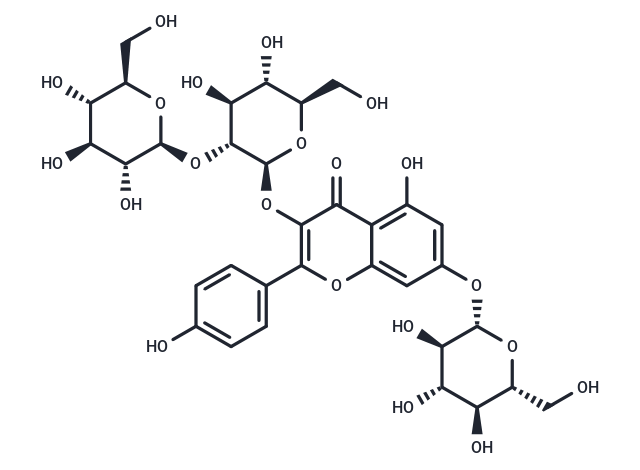Shopping Cart
- Remove All
 Your shopping cart is currently empty
Your shopping cart is currently empty

Kaempferol 3-sophoroside-7-glucoside, a flavonoid found in Lei leaves, exhibits bioactive properties including antioxidant and anti-obesity activities.

| Pack Size | Price | Availability | Quantity |
|---|---|---|---|
| 1 mg | $93 | In Stock | |
| 5 mg | $223 | In Stock | |
| 1 mL x 10 mM (in DMSO) | $589 | In Stock |
| Description | Kaempferol 3-sophoroside-7-glucoside, a flavonoid found in Lei leaves, exhibits bioactive properties including antioxidant and anti-obesity activities. |
| In vitro | The roasting process followed by a 30% EtOH extraction tended to enhance the content of kaempferol-3-sophoroside-7-glucoside. It effectively inhibited pancreatic lipase activity by 62.50 ± 4.81%, which was approximately 1.71 percentage points higher than that of the dried-nonroasted LCL extract (60.79 ± 3.75%). Its bioaccessible fraction obtained from in vitro digestion significantly and dose-dependently reduced intracellular lipid accumulation by adipocyte 3T3-L1 compared with a 30% EtOH extraction. At a concentration of 200 μg/mL, it inhibited lipid accumulation up to 29.55% in 3T3-L1 cells, which indicated that human digestive enzymes converted kaempferol-3-sophoroside-7-glucoside to kaempferol metabolites that have anti-obesity effects.[1] |
| In vivo | Apigenin 7-O-β-D-glucopyranoside and kaempferol-3-sophoroside-7-glucoside, among others, were the main chemical constituents of Pteris wallichiana J. Agardh extract (PEW). In LPS-induced Raw264.7 inflammation and DSS-induced mouse colon UC, PEW pretreatment can significantly reduce the expressions of inflammatory cytokines in vitro and in vivo. In DSS-induced UC mice, PWE can improve the abnormal pathological tissue damage by inhibiting oxidative stress and inflammation-related signaling pathways, and improve the intestinal barrier function.[1] |
| Molecular Weight | 772.66 |
| Formula | C33H40O21 |
| Cas No. | 55136-76-0 |
| Smiles | O(C1=C(OC=2C(C1=O)=C(O)C=C(O[C@@H]3O[C@H](CO)[C@@H](O)[C@H](O)[C@H]3O)C2)C4=CC=C(O)C=C4)[C@H]5[C@H](O[C@@H]6O[C@H](CO)[C@@H](O)[C@H](O)[C@H]6O)[C@@H](O)[C@H](O)[C@@H](CO)O5 |
| Relative Density. | 1.84 g/cm3 (Predicted) |
| Storage | store at low temperature,keep away from direct sunlight | Powder: -20°C for 3 years | In solvent: -80°C for 1 year | Shipping with blue ice. |

Copyright © 2015-2025 TargetMol Chemicals Inc. All Rights Reserved.